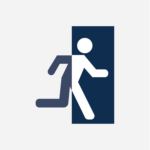Yolanda Sims, JD, MHA

In a healthcare setting, patients sometimes decide to self-discharge or leave against medical advice (AMA). Studies show that a variety of patient-related factors contribute to a patient’s decision to leave AMA, including:
- Patients may refuse to wait for the administrative delays in the discharge process.
- Patients may have pressing financial, domestic, or social concerns.
- Patients may disagree with their physician’s judgment of their health status and truly believe they are well enough to go home.
Steps to Take Before a Patient’s Departure Against Medical Advice
When a patient requests to leave AMA, you should take some crucial steps before their departure. Your institution should have a policy in place that outlines the process one should follow when handling AMA cases. A comprehensive AMA policy will address the following three areas:
Patient Capacity
Staff should determine whether the patient has the capacity to refuse treatment. Patients have the right to exercise free will. A person is allowed to refuse treatment if you can establish that their decision-making ability is not a concern. In cases where the patient exhibits signs of intoxication or other impairments, the protocol should be to put them under watchful observation for a reasonable period of time. Once the observation period has expired, you should revisit the capacity issue independently or with consultation.
Disclose the Risks and Consequences of Leaving AMA
Thoroughly disclose the risks and possible consequences of the patient leaving AMA. Patients should be informed about the serious nature of their medical condition and voluntarily agree that with this knowledge, they still insist upon leaving against the better judgment of their physician.
AMA Documentation
Document the entire AMA process in an AMA release form and the patient’s chart. If the patient refuses to sign the release form, read it to the patient and document their refusal to sign the form in the patient’s chart. In addition, have another staff member sign the chart to attest that the patient decided to leave AMA after you informed them of the possible risks and consequences of such a significant decision. A form in and of itself cannot prevent litigation, but it will serve as evidence that a thorough discussion took place prior to the patient leaving AMA.
References
Ibrahim S.A., Kent Kwoh C, Krishnan E. Factors Associated With Patients Who Leave Acute-Care Hospitals Against Medical Advice. Am J Public Health. 2007 December; 97(12): 2204-2208
Frederick Levy, MD, JD, Darren P. Mareneiss, JD, MD and Corianne Lacovelli, JD. J of Emerg Med. 2012; 43(3), 516-520. The Importance of a Proper AMA Discharge: How signing out AMA may Create Significant Liability Protection for Providers. Adapted Checklist.
